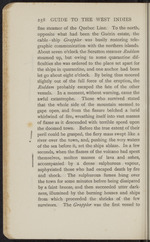| 1 |
 |
“...400, occupies a large enclosed ground beautifully
situated, with an extensive pavilion and visitors’
stand. The club, of which the Governor is pre-
sident, also affords opportunities for tennis, boxing,
and athletics. The Trinidad Turf Club holds race Racing,
meetings at midsummer and in December, which
attract very large crowds to the picturesque course
on the Savannah. Several minor meetings are
held in the country during the year, one always
taking place between Christmas and New Year’s
Day; apart from the very fair sport to be enjoyed,
the assemblage of so many races in quaint cos-
tumes in the Queen’s Park is a sight well worth
seeing. The members of the Trinidad Polo Club Polo,
play twice a week on the Savannah, and are “ at
home” to visitors on the second day. The St.
Andrew’s Golf Club has a large membership and
well-kept links on the Savannah. There is also
a Baseball Club, and football is played con- Baseball.
YirtPytr turrw /- hi. M a. ZsO
- £4...”
|
|
| 2 |
 |
“...TOBAGO
*53
These valleys are very fertile, each having its
own stream. The central portion is undulating,
with little valleys and conical hills, and the south
end is quite flat. About 53,000 acres are owned
privately; 6360 acres in the north are set apart
as a rain and forest reserve, and the remaining
13,640 acres are Crown lands available for sale.
The chief areas of cultivation are on the south
side, on which the slopes of the hills are less
steep than in the north. Scarborough (popula-
tion 2500), the capital of Tobago, is situated
at the south of the island, about 8 miles from
the south-west point. The only other town is
Plymouth, really only a village (population 1200),
on the north side, 5 miles from Scarborough.
Around the coast there are many excellent bays,
most of which are well sheltered and afford safe
anchorage with deep soundings. Indeed, Man-
o’-War Bay, a very spacious harbour, is said to
be capable of affording shelter to the whole of the
British fleet! What is most wanted...”
|
|
| 3 |
 |
“...258 GUIDE TO THE WEST INDIES
fine steamer of the Quebec Line. To the north,
opposite what had been the Guérin estate, the
cable-ship Grappler was busily restoring tele-
graphic communication with the northern islands.
About seven o’clock the Scrutton steamer Roddam
steamed up, but owing to some quarantine dif-
ficulties she was ordered to the place set apart for
the ships in quarantine, and one anchor had been
let go about eight o’clock. By being thus moored
slightly out of the full force of the eruption, the
Roddam probably escaped the fate of the other
vessels. In a moment, without warning, came the
awful catastrophe. Those who survived stated
that the whole side of the mountain seemed to
gape open, and from the fissure belched a lurid
whirlwind of fire, wreathing itself into vast masses
of flame as it descended with terrible speed upon
the doomed town. Before the true extent of their
peril could be grasped, the fiery mass swept like a
« river over the town, and, pushing the very waters...”
|
|
| 4 |
 |
“...WEST INDIAN INDUSTRIES 299
Cotton is planted in August and September, just Cultivation,
before the rains, in order that dry weather may
be obtained during the period in which the crop
is picked. It is best planted 20 inches apart,
in rows which are 5 feet apart, four seeds being
planted in each hole, 6 lbs. of seed per acre being
thus used. As soon as the plants are a fortnight
old, the weakest ones are pulled out, leaving the
two strongest in each hole, and a fortnight later
the weaker of the two remaining plants is removed.
This is the critical period, as heavy rains or high
winds may damage, if not ruin, the crop. The
picking is conducted by men, women, and children, Picking,
and expert labourers are able to pick about 100
lbs. of seed-cotton per day. They hold the boll
firmly with the left hand aud remove the seed-
cotton with the right, the price usually paid for
this operation being |d. to Jd. per lb. of seed-
cotton. The cotton is then sunned until it is
thoroughly dry, stained cotton...”
|
|
